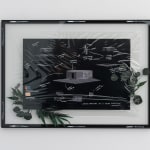Cécile B. Evans
Nomadic Structure for a Future Adaptation (Exploded [Giselle's House]), 2021
C-type print, cellulose biofilm, paint, preserved plants, vintage Italian wallpaper and glass
70 x 50 cm
27 1/2 x 19 3/4 inches
27 1/2 x 19 3/4 inches
Copyright The Artist
Photo: Dirk Tacke
Weitere Abbildungen
„Nomadic Structure for a Future Adaptation (Exploded [Giselle's House])“ (2021) ist eine Collage aus einem Fotodruck, einem zellulosen Biofilm, sowie konservierten Pflanzen und Tapetenstücken. Die Wandarbeit steht in Verbindung zum...
„Nomadic Structure for a Future Adaptation (Exploded [Giselle's House])“ (2021) ist eine Collage aus einem Fotodruck, einem zellulosen Biofilm, sowie konservierten Pflanzen und Tapetenstücken. Die Wandarbeit steht in Verbindung zum vierten Teil „Future Adaptations (an understudy for Giselle)“ (2022) der Video-Reihe und zeigt eine architektonische Installation, die in der Verfilmung als Schauplatz auftaucht. Diese ist inspiriert von Edgar Reinhards „Nomadic Architecture-Pavillon“, der 1971 von dem Unternehmen „Dow Chemical“ zur Bewerbung von Chemikalien zur Aufbereitung von Wasser auf der IFAT-Fachmesse in München gebaut wurde. Dessen Gerüststruktur enthielt konservierte Pflanzen, mikrobiellen Brennstoffzellen und eine elektrische Mechanik und war mit Wasser gefüllt, auf dem die Besucher:innen liefen. Evans greift dies als Ausstellungsarchitektur auf, um die Version von Giselles Geschichte in Verbindung mit Superbakterien und anderen Systemen zu erzählen. Die Collage, ist als Skizze und Anleitung Teil der Entstehung dieses filmischen Narrativs und greift gleichzeitig Aspekte des Videos auf, indem der zellulose Biofilm als organisches Material, in das Werk eingebettet ist und sich als Behälter für Zellen und Ideen, selbst in einem ständigen Zustand des Lebens und Sterbens befindet.
"Nomadic Structure for a Future Adaptation (Exploded [Giselle's House])" (2021) is a collage of a photographic print, a cellulose biofilm, and preserved plants and pieces of wallpaper. The wall piece is related to the fourth part "Future Adaptations (an understudy for Giselle)" (2022) of the work series and shows an architectural installation that appears as a setting in the film version. This is inspired by Edgar Reinhard's "Nomadic Architecture Pavilion", which was built in 1971 by the company "Dow Chemical" to promote chemicals for the treatment of water at the IFAT trade fair in Munich. Its scaffolding structure contained preserved plants, microbial fuel cells, and an electrical mechanism, and was filled with water on which visitors walked inside. Evans takes this up as exhibition architecture to tell the version of Giselle's story in conjunction with superbacteria and other systems. The collage, as sketch and guide, is part of the making of this cinematic narrative and at the same time picks up aspects of the video, in that the cellulose biofilm as organic material, is embedded in the work and as a container for cells and ideas, is itself in a constant state of living and dying.
"Nomadic Structure for a Future Adaptation (Exploded [Giselle's House])" (2021) is a collage of a photographic print, a cellulose biofilm, and preserved plants and pieces of wallpaper. The wall piece is related to the fourth part "Future Adaptations (an understudy for Giselle)" (2022) of the work series and shows an architectural installation that appears as a setting in the film version. This is inspired by Edgar Reinhard's "Nomadic Architecture Pavilion", which was built in 1971 by the company "Dow Chemical" to promote chemicals for the treatment of water at the IFAT trade fair in Munich. Its scaffolding structure contained preserved plants, microbial fuel cells, and an electrical mechanism, and was filled with water on which visitors walked inside. Evans takes this up as exhibition architecture to tell the version of Giselle's story in conjunction with superbacteria and other systems. The collage, as sketch and guide, is part of the making of this cinematic narrative and at the same time picks up aspects of the video, in that the cellulose biofilm as organic material, is embedded in the work and as a container for cells and ideas, is itself in a constant state of living and dying.
![Cécile B. Evans, Nomadic Structure for a Future Adaptation (Exploded [Giselle's House]), 2021](https://artlogic-res.cloudinary.com/w_1600,h_1600,c_limit,f_auto,fl_lossy,q_auto/artlogicstorage/maxgoelitz/images/view/61aca5696e96fd49706339a9879d7639j/maxgoelitz-c-cile-b.-evans-nomadic-structure-for-a-future-adaptation-exploded-giselle-s-house-2021.jpg)
![Cécile B. Evans, Nomadic Structure for a Future Adaptation (Exploded [Giselle's House]), 2021](https://artlogic-res.cloudinary.com/w_1600,h_1600,c_limit,f_auto,fl_lossy,q_auto/artlogicstorage/maxgoelitz/images/view/6e2b6380a27a5b0b4d0dd0121c143dadj/maxgoelitz-c-cile-b.-evans-nomadic-structure-for-a-future-adaptation-exploded-giselle-s-house-2021.jpg)
![Cécile B. Evans, Nomadic Structure for a Future Adaptation (Exploded [Giselle's House]), 2021](https://artlogic-res.cloudinary.com/w_1600,h_1600,c_limit,f_auto,fl_lossy,q_auto/artlogicstorage/maxgoelitz/images/view/508c763c2e8dda80cdac7dc8dffc2319j/maxgoelitz-c-cile-b.-evans-nomadic-structure-for-a-future-adaptation-exploded-giselle-s-house-2021.jpg)


